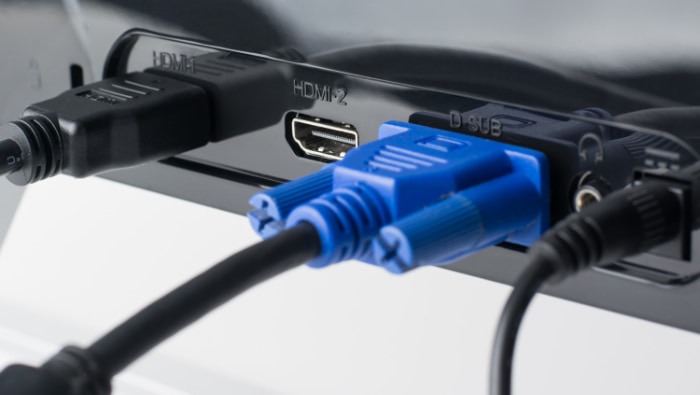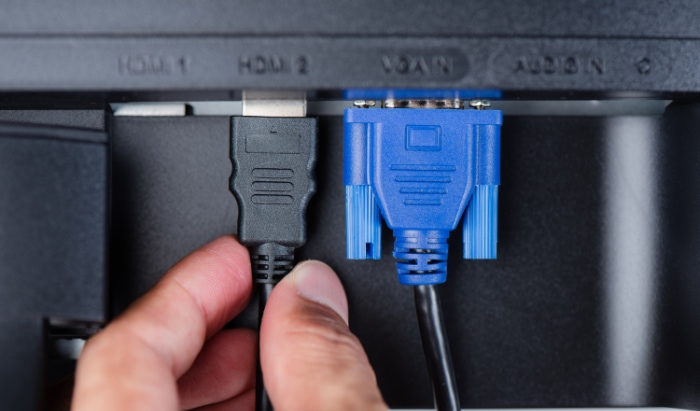HDMI vs. VGA: Duel of the Displays

Technology continuously evolves, driving transformations in how we connect and interact with our devices. In this dynamic landscape, two key connectors have significantly influenced our audio-visual experiences: HDMI and VGA.
These interfaces, distinct in their design and functionality, are essential to our daily technology interactions, ranging from professional office presentations to immersive home entertainment systems. Whether you’re a tech aficionado, a professional in search of optimal display solutions, or simply curious about the cables connecting your screens, this exploration aims to demystify the complex world of digital connectivity.
Historical Context and Development
The journey of HDMI and VGA, two of the most influential connectors in the realm of audio-visual technology, reflects the evolution and shifting needs of the digital age. From the early days of computing to the current era of high-definition multimedia, understanding their historical context provides valuable insights into their sustained relevance and technological advancements.
VGA: The Early Standard
Video Graphics Array (VGA), introduced by IBM in 1987, marked a significant leap in computer display technology. It was designed as a video display controller and quickly became the standard for computers, replacing earlier graphics standards like CGA and EGA. VGA offered higher resolution, more colors, and greater flexibility, setting a benchmark in the industry.
Its analog signal transmission was a key feature, enabling compatibility with a wide range of monitors and projectors, thus cementing its place in the computing world for decades.
HDMI: Revolutionizing Digital Connectivity
High-Definition Multimedia Interface (HDMI), introduced in 2002, represented a paradigm shift in audio-visual connectivity. Developed by a consortium of major electronics manufacturers, HDMI was designed to meet the growing demand for high-definition content.
It facilitated the transmission of both audio and video signals through a single cable, a stark contrast to VGA’s video-only capability. HDMI’s digital signal transmission not only supported higher resolutions but also ensured a more efficient and streamlined connection between devices, from HDTVs and gaming consoles to computers and digital projectors.
Evolving Through Generations
Both VGA and HDMI have undergone significant evolution since their inception. VGA adapted to the changing tech environment through various iterations, maintaining its relevance in a digital world.
HDMI, meanwhile, has seen multiple versions, each enhancing its capabilities in terms of resolution, color depth, and bandwidth. These continuous improvements reflect the dynamic nature of technology, where adaptation and advancement are key to meeting the ever-growing demands of users and industries alike.
Technical Specifications
The technical specifications of HDMI and VGA connectors are foundational to their functionality and application in various devices. By examining these specifications, we gain a deeper appreciation of how each interface serves distinct roles in the transmission of audio and visual data.
VGA: Analog Legacy
VGA connectors primarily transmit analog video signals. The standard VGA connector, a 15-pin DE-15, carries RGBHV (Red, Green, Blue, Horizontal Sync, Vertical Sync) signals. This configuration supports resolutions up to 640×480 in 16 colors or 320×200 in 256 colors, known as the 640×480 VGA standard.
However, over time, extended versions like Super VGA (SVGA) emerged, offering resolutions up to 800×600 and beyond. The analog nature of VGA means it is susceptible to signal degradation over long distances and is limited in its capacity to support higher resolutions compared to digital standards.
HDMI: Digital Advancement
HDMI stands for digital audio and video transmission. Unlike VGA, HDMI can carry uncompressed video and compressed or uncompressed audio on a single cable.
The standard HDMI connector, Type A, features 19 pins and supports various formats, including standard, enhanced, high-definition, and Ultra-HD video. It also provides a communication channel between the connected devices, enabling features like HDCP (High-bandwidth Digital Content Protection) for digital rights management and CEC (Consumer Electronics Control) for integrated device control.
HDMI has evolved through several versions, from HDMI 1.0 to the latest HDMI 2.1, enhancing its capacity for higher bandwidth (up to 48 Gbps), resolution (up to 10K), and dynamic range, making it a robust choice for modern high-definition multimedia applications.
Quality and Performance
When comparing HDMI and VGA, the aspects of quality and performance are central to understanding their impact on user experience. These factors not only influence the choice between the two but also determine their suitability for various applications, from everyday computing to professional-grade media production.
VGA: Consistency in an Analog Format
VGA, with its analog signal transmission, provides consistent quality for standard definition video. While it excels in compatibility with a wide range of devices, its performance is limited by resolution and color fidelity.
The maximum resolution achievable with VGA is lower than modern digital standards, often resulting in less sharp and less vibrant images. Additionally, the analog nature of VGA can lead to signal degradation, especially over longer cable lengths, affecting image clarity and stability.
However, for applications where high resolution and color depth are not critical, such as simple presentations or basic video playback, VGA remains a reliable option.
HDMI: Clarity and Versatility in Digital
HDMI interfaces shine in their ability to deliver high-definition, crisp, and vibrant images with excellent color accuracy. The digital signal transmission ensures that there is minimal loss of quality, even over longer distances.
HDMI supports a wide range of resolutions, from standard 1080p to 4K and beyond, making it ideal for applications requiring high-resolution displays, such as HD television broadcasting, gaming, and multimedia presentations. Moreover, HDMI’s capacity to carry both audio and video signals simplifies setup and enhances the overall multimedia experience.
The progressive versions of HDMI have further improved performance, offering features like higher refresh rates, deeper color spaces, and enhanced audio quality, catering to the ever-increasing demands of advanced digital media.
Compatibility and Use Cases

Understanding the compatibility and ideal use cases of HDMI and VGA is essential for selecting the right interface for specific needs. Each has its unique strengths, making them suitable for different environments and applications.
VGA: Enduring Legacy Compatibility
VGA’s long-standing presence in the tech world has solidified its compatibility with a vast array of legacy systems. This includes older computers, monitors, projectors, and even some modern devices that still support VGA for backward compatibility.
VGA’s analog signal is also less prone to compatibility issues with older video equipment, making it a go-to choice for situations involving legacy technology. Typical use cases for VGA include classroom or business presentations using older projectors, connecting to legacy monitors, and in setups where high-definition output is not a priority.
HDMI: Broad Modern Device Support
HDMI’s digital interface aligns it with the majority of modern digital devices, from HDTVs and computer monitors to gaming consoles and digital cameras. Its ability to transmit both high-quality video and audio makes it ideal for a wide range of high-definition applications.
Common HDMI use cases include home theaters for a comprehensive audio-visual experience, gaming setups requiring high resolution and fast refresh rates, and professional environments where high-definition video output is necessary. HDMI’s evolving standards have also ensured its compatibility with emerging technologies like 4K and 8K televisions, VR devices, and advanced audio systems.
Advantages and Limitations
Each connector, HDMI and VGA, brings its unique set of advantages and limitations to the table. Understanding these can help users make informed decisions based on their specific requirements and the capabilities of these interfaces.
Advantages of VGA
VGA’s primary advantage lies in its widespread legacy support. It’s highly compatible with a range of older devices, making it indispensable in environments where newer technology is not present.
The simplicity of VGA’s analog signal transmission also means that it’s less prone to certain digital compatibility issues. Additionally, VGA cables and connectors are generally more affordable and readily available, making them a cost-effective solution for basic display needs.
Limitations of VGA
The most significant limitation of VGA is its restricted video quality. It supports lower resolutions and color depths compared to modern digital standards, leading to less sharp and vibrant images.
The analog nature of the signal also means it can degrade over distance, affecting the image clarity. Moreover, VGA does not support audio transmission, requiring additional cabling for sound.
Advantages of HDMI
HDMI stands out for its high-definition video and audio transmission capability. It supports a wide range of resolutions, including 4K and beyond, and provides enhanced color depth and clarity.
The integrated audio support simplifies cabling requirements and improves the overall multimedia experience. HDMI also offers advanced features like CEC for device control and HDCP for content protection, aligning it with modern digital requirements.
Limitations of HDMI
HDMI’s limitations are primarily related to its digital nature. Compatibility issues can arise with older, non-digital devices.
Additionally, high-quality HDMI cables, especially those required for the latest standards like HDMI 2.1, can be more expensive than VGA cables. Lastly, as technology evolves, older versions of HDMI may not support the latest features, such as enhanced refresh rates or higher resolutions, necessitating upgrades.
Cost Considerations
When selecting between HDMI and VGA, cost is a crucial factor that influences both individual and organizational decisions. The pricing of these connectors varies based on several factors, including performance capabilities, build quality, and brand.
VGA: Affordable and Accessible
VGA cables and connectors are generally more affordable, reflecting their simpler, analog technology and widespread manufacturing. The cost-effectiveness of VGA makes it a practical choice for basic video requirements, especially in educational or business settings where high-definition output is not a priority.
The longevity of VGA in the market has also led to a wide availability of cost-effective, generic options, further driving down prices.
HDMI: Varied Pricing Based on Performance
HDMI cables and connectors exhibit a broader price range due to their varying performance levels and features. Basic HDMI cables are competitively priced and suitable for most everyday applications.
However, higher-end HDMI cables, designed for ultra-high-definition and advanced features like Ethernet support, can be significantly more expensive. The cost increases with the latest versions of HDMI, such as HDMI 2.1, which provide enhanced bandwidth and support for features like dynamic HDR and high frame rates.
Conclusion
HDMI and VGA, each with their distinct technical specifications, quality, performance, compatibility, and cost considerations, cater to different needs in the audio-visual domain. VGA, a veteran in the field, remains a reliable option for basic video requirements, especially in settings where high-definition is not a priority.
Its affordability and legacy system compatibility make it a practical choice in many scenarios. On the other hand, HDMI stands out as the preferred interface for modern, high-definition applications, offering superior video and audio quality, higher resolution support, and advanced features.
While it may come at a higher cost, especially for cutting-edge versions, its benefits in multimedia-intensive environments are undeniable.
This comparative analysis underscores the importance of selecting the right interface based on specific needs and contexts. Users should consider factors such as the required video and audio quality, compatibility with existing equipment, and budget constraints when making their choice.
HDMI and VGA, despite their differences, continue to play vital roles in shaping our digital experiences, highlighting the dynamic and evolving nature of technology in accommodating a diverse range of user requirements.


